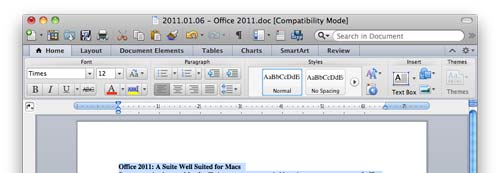
So, you received a new Mac for Christmas – you are probably going to want some sort of office suite for writing letters or papers, creating presentations and so on. There are a number of respectable choices out there, including Apple’s very good iWork suite. Nevertheless, Microsoft’s Office has long held the status of the gold standard of suites and its components have a long history on the Mac. In this review we investigate whether it deserves a place on your computer.
Many recent switchers to the Mac do not realize the long history Microsoft has had on the Macintosh – Word was released on the Mac years before Word for Windows. Over the years, Microsoft invested enough effort into its suite to continue to give Mac users good reasons to use it. Office 2004, for example, was a well designed, stable and feature packed office suite. Moreover, Office for Mac has traditionally provided excellent compatibility with its Windows cousin.
However, a speed bump arrived a few years back: Apple’s decision to switch to Intel processors. Because of Office’s long history on the Mac, this required the company to rework a significant portion of the underlying code for the next upgrade, Office 2008.
While Office 2008 added native Intel support, in other ways it felt like a significant step backwards. Curious issues crept into the application: window behavior was odd (clicking on the title bar caused a different reaction than clicking on a document, for example), documents crashed inexplicably and the programs were generally sluggish. A toolbar similar to the Windows version’s “ribbon” was added, but it had very little real use and was plagued by overly gaudy, slow visual effects. On the compatibility front, Visual Basic support was dropped from the applications, causing compatibility problems with some, more advanced Windows-created Office documents.
Happily, we have found that Office 2011 remedies all of these issues, making the suite feel like the rightful upgrade to the now aged Office 2004. If Office 2008 was the line’s Windows Vista – an upgrade with important structural changes, but also serious issues – then Office 2011 is analogous to Windows 7: Office 2008 done right. Visual Basic support is fully on board, the user interface quirks have been largely wiped out and Microsoft has found ways to balance the innovative ribbon toolbar from Office for Windows with Macintosh user interface conventions. Best of all, the suite is much faster, especially on startup.
Office for Mac remains notably ahead of alternatives such as iWork or OpenOffice.org in a few important ways. For better or worse, collaboration with others using Office remains a key one – though import and export functions of Office competitors have grown significantly better, none of the alternatives are as good at dealing with the ubiquitous Word, Excel and PowerPoint files as Office itself.
 |
|
Word 2011's ribbon compactly provides access to all of the most common formatting options. |
Word seems to be the application that has the largest advantage over its competition for most users, benefiting from both familiar concepts and sensible, easy methods for common tasks that simply make getting work done easier. Those who deal with meetings or classes, for example, will likely find Word’s notebook view sets it apart, providing a way to type text notes that are automatically linked by the time of writing to an audio recording made by a basic recorder built into the application. When one reviews the notes, clicking the margin next to a new paragraph will cue up the appropriate portion of the audio track.
Taking a page from Apple’s iWork suite, Office 2011 comes with a very large selection of predesigned, attractive templates for letters, brochures, PowerPoint presentations and more. The improved PowerPoint templates are especially notable, bringing the quality of templates more in line with that of Apple’s Keynote.
PowerPoint effects for presentations have also been improved, with some new, eye catching ones that, if used thoughtfully, could improve one’s presentation. Effects are now clustered into helpful categories, such as “subtle” and “exciting,” to make selecting a transition or animation appropriate to the subject and audience easier.
In lieu of the floating toolbox in which most formatting functions were handled in previous versions of Office for Mac, Office 2011 situates the majority of controls within the ribbon toolbar. This is especially handy in Word, allowing it to take up less room, thus freeing up space for, say, a reference document one might be citing in a paper or project. Though the ribbon is not exactly a normal interface convention for the Mac, we found it to be a very functional addition. (Those who dislike the ribbon can turn it off and add a traditional formatting toolbar to the document window in its place.)
We appreciated that many functions, such as the aforementioned PowerPoint transitions and animations, are actually more conveniently located in PowerPoint for Mac’s ribbon toolbar than in the equivalent ribbon on the application’s Windows equivalent. Clearly, Microsoft’s Mac Business Unit (MBU) did not spend the last few years merely bringing over Office for Windows concepts to the Mac, but refining and adapting them.
Other interface tweaks abound, making the suite feel more Mac-like and easier to use. For example, a zoom slider on the bottom of the window works like the one found in iPhoto and Finder, making it a snap to increase and decrease the size of the document quickly. An improved search facility builds the word search box into the window, ala Safari, allowing one to look for multiple occurrences of a word without having to juggle different windows. As with the latest iLife apps and numerous other Mac apps, Microsoft has also added a full screen mode to Word, allowing one to write free of the distraction of desktop clutter.
A well-designed, centralized media browser is also a welcome feature. Using a single panel, one can quickly access iLife media (iPhoto, iMovie and iTunes files), Microsoft’s selection of included clip art (and any downloaded from Office’s online clip gallery), common symbols (such as fractions and monetary symbols) and shapes. This media browser feels very reminiscent of the iLife media browser, albeit with several additional categories that increase its usefulness.
Perhaps one of the most ingenious additions is a “reorder objects” function in Word’s publishing layout mode and PowerPoint. To deal with the ever-pesky problem of trying to deal with a stack of various objects (pictures, text, shapes and so on) that overlap on each other in a document, one can activate this mode and see a semi-3D perspective that makes it simple to reposition objects up and down in the “stack.”
Office 2011 also adds collaborative editing as a built-in feature, providing a way for one to “coauthor” documents live with others who are using Office for Mac, the Office Web apps or Office for Windows. This brings the convenience of team collaboration on Google Docs to Word – perfect for the student doing a group research paper or co-workers interacting on a PowerPoint presentation.
Unfortunately, this feature felt like one of the least polished in the new suite, with relatively long loading times on opening and saving documents during which the suite was unresponsive. While writing this review in Word 2011, we also experienced an intermittent problem in which Word was unable to reload the document and confusingly reported that JavaScript had been disabled (where it was disabled at was unclear). While the problem resolved itself for us after about half an hour, we found numerous reports of other users encountering this issue on both Office 2011 for Mac and Office 2010 for Windows.
We would like to see Microsoft spend more time refining this feature through updates both to its Skydrive online interface and within the office suite. Being able to collaborate within Office itself is an extremely appealing idea; however, it needs to be at least as fast and reliable as Google Docs for it to be truly usable.
Another important change in Office 2011 is that Microsoft Outlook has replaced Entourage (itself descended from the Mac version of Outlook Express) with the aim of bringing more parity between Mac and Windows users on the groupware front. Although improved Microsoft Exchange compatibility in the core of the OS, as of the release of Snow Leopard in 2009, would seem to have lessened the need for this somewhat, those making a shift from a Windows environment will appreciate the more familiar, unified groupware experience of Outlook 2011. The addition of an import tool for Outlook for Windows PST files means that moving contacts, calendars and e-mail from an existing Outlook configuration is much easier than it was in the past.
Many of the changes highlighted in this review may sound relatively minor, yet they all serve to make using Office for Mac a better, more streamlined experience. When one considers how much time the average person spends with a word processor alone, even little changes can be big productivity boosters – especially when combined with dozens of other, similar tweaks.
In our trial of the components of Office 2011, we believe that the suite has not only maintained a lead on features over alternative Mac suites, but has also succeeded in providing a more convenient user interface than its closest competitor, Apple’s iWork ’09. Thanks to its smart blend of Mac concepts with Microsoft’s best in-house ideas, Office 2011 may very well be the best office suite available on any platform at the present time.
Overall, while it may sound odd to be excited about an office suite, Office 2011 deserves some excitement. Given its aggressive pricing, most Mac users – not just those new Mac users who do not have an office suite yet – should consider enjoying the suite’s applications on their own computers (Microsoft; $99 street price for the non-commercial Home and Student Edition, $179 street price for the commercial Home and Business Edition; microsoft.com/mac).